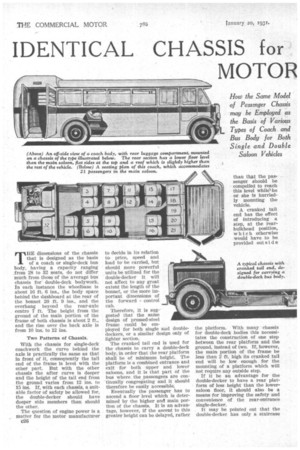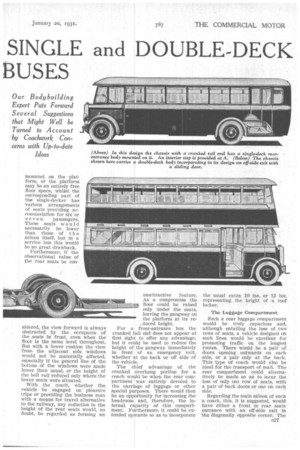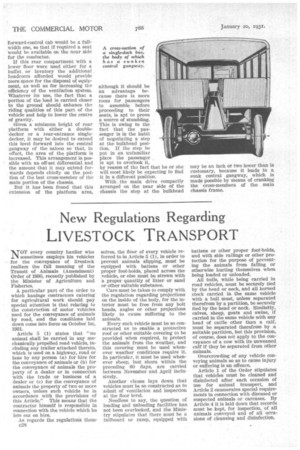IDENTICAL CHASSIS for MOTOR SINGLE and DOUBLE-DECK BUSES
Page 48

Page 49

Page 50

If you've noticed an error in this article please click here to report it so we can fix it.
THE dimensions of the chassis that is designed as the basis of a coach or single-deck bus body, having a capacity ranging from 28 to 32 seats, do not differ much from those of the average bus chassis for double-deck bodywork. In each instance the wheelbase is about 16 ft. 6 ins., the body space behind the dashboard at the rear of the bonnet 20 ft. 9 ins., and the overhang beyond the rear-axle centre 7 ft. The height from the ground of the main portion of the frame of both chassis is about 2 ft., and the rise over the back axle is from 10 ins. to 12 ins.
Two Patterns of Chassis.
With the chassis for single-deck coachwork the curve behind the axle is practically the same as that in front of it, consequently the tail end of the frame is level with the other part. But with the other chassis the after curve is deeper and the height of the tail end from the ground varies from 12 ins. to 15 ins. If, with each chassis, a suitable factor of safety be allowed for, the double-decker should have deeper side members than should the other.
The question of engine power is a matter for the motor manufacturer e26
to decide in its relation to price, speed and load to be carried, but should more powerful units be utilized for the' double-decker it will not affect to any great extent the length of the bonnet, or the more important dimensions of the forward control• cab.
Therefore, it is suggested that the smile design of pressed-steel frame could be employed for both single and doubledeckers, or a similar design only of lighter section. The cranked tail end is used for the chassis to carry a double-deck body, in order that the rear platform shall be of minimum height. The platform is a combined entrance and exit for both upper and lower saloons, and it is that part of the bus where the _passengers are continually congregating and it should therefore be easily accessible.
Eventually the passenger has to ascend a door level which is determined by the higher and main portion of the chassis. It is an advantage, however, if the ascent to this greater height can be delayed, rather the platform. With many chassis for double-deck bodies this necessitates the construction of one step between the rear platform and the ground, instead of two. If, however, the main portion of the frame be less than 2 ft. high its cranked tail end will be low enough for the mounting of a platform which will not require any outside step.
If it be an advantage for the double-decker to have a rear platform of less height than the lowersaloon floor, it should also be a means for improving the safety and convenience of the rear-entrance single-decker.
It may be pointed out that the double-decker has only a staircase sidered, the view forward is always obstructed by the occupants of the seats in front, even when the floor is the same level throughout. But with a lower cushion the view from the adjacent side windows would not be materially affected, especially if the general line of the bottom of the windows were made lower than usual, or the height of the belt rail reduced only where the lower seats were situated.
With the coach, whether the vehicle be engaged on pleasure trips or providing the business man with a means for travel alternative to the railway, any reduction in the height of the rear seats would, no doubt, be regarded as forming an unattractive feature. As a compromise the floor could be raised only under the seats, leaving the gangway on the platform at its re, duced height.
For a front-entrance bus the cranked tail end does not appear at first sight to offer any advantage, but it could be used to reduce the height of the gangway immediately in front of an emergency exit, whether at the back or off side of the vehicle.
The chief advantage of the cranked overhang portion for a coach would be when the rear compartment was entirely devoted to the carriage of luggage or other special purposes. There would then be an opportunity for increasing the headroom and, therefore, the internal, capacity of this compartment. Furthermore, it could he extended upwards so as to incorporate the usual extra Ill ins. or 12 ins. representing the height of a roof locker.
The Luggage Compartment.
Such a rear luggage compartment would be truly capacious and, although entailing the loss of two rows of seats, a vehicle designed on such lines would be excellent for promoting traffic on the longest routes. There would be a pair of doors opening outwards on each side, or a pair only at the back. This type of coach would also be ideal for the transport of mail. The rear compartment could alternatively be made so as to incur the loss of only one row of seats, with a pair of back doors or one on each side.
Regarding the main saloon of such a coach, this, it is suggested, would have either a front or rear main entrance with an off-side exit in the diagonally opposite corner. The forward-control cab would be a fullwidth one, so that if required a seat would be available on the near side for the conductor.
If this rear compartment with a lower floor were used either for a buffet, or lavatory the additional headroom afforded would provide more space for the disposal of equipment, as well as for increasing the efficiency of the ventilation system. Whatever its use, the fact that a portion of the load is carried closer to the ground should enhance the riding qualities of this part of the vehicle and help to lower the centre of gravity.
Given a minimum height of rear platform with either a doubledecker or a rear-entrance singledecker, it may be desired to extend this level forward into the central gangway of the saloon so that, in effect, the area of the platform is increased. This arrangement is possible with an off-set differential and the amount that it may extend forwards depends chiefly on the position of the last cross-member of the main portion of the chassis.
But it has been found that this extension of the platform area, although it should be an advantage because there is more room for passengers to assemble before proceeding to their seats, is apt to prove a source of stumbling. This is owing to the fact that the passenger is in the habit of negotiating a step at the bulkhead position. If, the step be put in an unfamiliar place the passenger is apt to overlook it, by reason of the fact that he or she will most likely be expecting to find it in a different position.
With .• the main drive compactly arranged on the near side of the chassis the step at the bulkhead may be an inch or two lower than is customary, because it leads to a sunk central gangway, which is made possible by means of cranking the cross-members ef the main chassis frame.












































































































